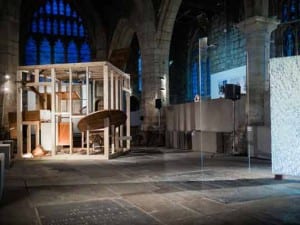Jo McGonigal addresses how the compositional and material components of painting effect the experimental basis of the viewer: not what the painting means but what it does. She uses found and everyday materials, alongside the made, to closely examine the formal grammar of pictorial language. Recently longlisted for the Aesthetica Art Prize and published in the Future Now Annual with Unmaking Painting I, (2014), McGonigal shares an insight into her practice.
A: In your work you use found and everyday objects alongside the made to create compositional “spatialised” paintings which break down the so-called “frame” between the artwork and the viewer. Can you discuss the role and importance of the viewer in terms of their response to your work?
JM: I want the work to engage both the body and architecture. My interest has been with using surface and distance to destabilise the normative vertical upright position of the viewer, when encountering painting. I resist the pressure of a single or stable vantage point, and aim to keep the viewer moving to fully experience the work.
Some of the paintings insist upon the viewer to stride back and forth, or lean into a diagonal position – strategies to self-consciously activate the body as much as the eye. These ideas of ‘choreographing’ the viewer are becoming more important and were examined within Real Painting, a group exhibition I curated with Deb Covell in 2015 at Castlefield Gallery, Manchester.
A: You describe your practice in terms of a cookery book, listing the key items of a painting as distance, perspective, edge, line, translucency and structures of colour.” How do you feel that each individual’s response to the same painting can be affected?
JM: The work begins from a position of ‘undoing’ or ‘unmaking’ painting, which in a sense comes from quite a traditional view of image making within art history. For instance, I have spent a lot of time looking at the work of Poussin and other Baroque painters, to examine their processes for presenting deep complex space, translucency, stillness and the transitory, pushing colour forward, zigzag eye movement, dark to light, etc.
I am fascinated with this language far beyond narrative or any other external references, it is the act of looking that I’m concerned with. With my work, I’m getting between the planes of painting, trying to experience the ‘inside,’ its interiority. By taking painting apart, getting inside the work, I can examine/reveal its interior and use this as the framework to examine what else painting can do, what makes a painting and reconsider its functionality when its physical presence holds the same value as the image plane.
A: You mention that in Unmaking Painting I (2014) you are fascinated with looking at what a painting “does” rather than what it means. Can you explain this aspect of your practice?
JM: By placing the emphasis on painting’s physical structure over the pictorial, the work upends traditional ideas of representation by using real things, including the gallery itself, to become the ‘image’ in the painting. The painting is not an autonomous independent image or thing but an interacting presence that incorporates the architectural site and its spatial particularities to unite painting and space, to examine in part, what constitutes space in relation to painting.
By getting behind the scenes or underneath the surface, exploring pictorial structures through use of the made and the found, the condition of each element, matter/material itself becomes the ‘actant’ and conduit of meaning. Material components are considered in how they evoke tactile sensation through looking, a haptic, sensorial response. The work extends into space, occupies and activates architecture, where the frontal fixated focused vision is disrupted and we begin to experience painting as we experience the world, which isn’t just visionary.
A: Your projects play with the conventional notion of painting, suggesting that instead of needing to use paint an artist can look to other materials. With this you inspire questions about the very nature of painting itself. What do you consider justifies a piece as a painting?
JM: I’m investigating new ways of making paintings that isn’t reliant on producing discreet “things” but instead relates the “thingness” of its physical and material existence, its story, to the space that it occupies. The work projects out of pictorial space and occupies the same space as the viewer, it colonises or claims the space in a very conscious way, hustling the other occupants, the viewer.
A: What are you currently working on or planning to create?
JM: I have a solo show coming up next month in Glasgow with Patricia Fleming Gallery which involves several new pieces and one new spatial painting that makes a link between both the gallery and painting studios opposite. I’m very excited about this opportunity as I’ve a strong connection with Scotland and Glasgow is such a great city for studying, making and showing work. I also have a further solo show in London next year and will be participating in the Biennial of Non-Objective Art in Lyon, France towards the end of 2017. Following last year’s success with Real Painting, Deb Covell and I are working on a follow up so watch this space for another International Painting show in 2018!
To see more of Jo McGonigal’s work, visit www.jomcgonigal.co.uk
Pick up a copy of Future Now, the Aesthetica Art Prize Annual featuring Jo McGonigal’s work: www.aestheticamagazine.com/buy/future-now-2016
Credits
1. Jo McGonigal, Unmaking Painting I (2014)





